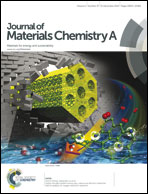Local organization of Fe3+ into nano-CeO2 with controlled morphologies and its impact on reducibility properties†
Abstract
Ce and Fe are the main metal additives which have been tested by many laboratories for their catalytic activity at low temperature for soot oxidation in diesel engines.The key role and impact of Fe on the reducibility properties of ceria have been investigated on the basis of composition and structural features considering various synthesis routes. Two different procedures were used to prepare iron-substituted cerium dioxide Ce1−xFexO2−x/2: a classical co-precipitation route followed by annealing at T = 600 °C and an unusual microwave-assisted hydrothermal synthesis at T = 200 °C. The highest surface areas around 100 m2 g−1, have been obtained for oxides containing the largest Fe amount and prepared by the microwave-assisted route. Solid solutions were obtained up to x = 0.15 and 0.20 through microwave-assisted and co-precipitation routes, respectively. The highest decrease of the lattice parameter is observed for compounds prepared by the microwave-assisted route. The TEM analysis reveals a nano-cubic shape (with mainly {001} planes) for compounds prepared by the microwave-assisted route and containing low Fe amount. For the other compounds prepared also by the co-precipitation process, a nano-polyhedron shape corresponding to a thermodynamically stable morphology is observed. EPR (T = 5 K, very low Fe rates), Mössbauer (room temperature, x = 0.10) and XANES–EXAFS (RT and T = 20 K) spectroscopies studies showed that Fe ions adopt the trivalent state and are located in isolated distorted (orthorhombic and axial distortions) octahedra or form Fe clusters. The local organization of Fe3+ plays a key role in the oxygen vacancy distribution and consequently the reducibility properties of the Ce1−xFexO2−x/2 solid solution. For the compounds prepared by the microwave-assisted route, a large proportion of Fe3+ is located in isolated distorted octahedral sites that contribute to affect a high number of Ce4+ nearest neighbors with a high mobility of oxygen vacancies. In this case, the oxygen vacancies are well distributed around Ce4+ and Fe3+. In the case of compounds obtained by the co-precipitation route, Fe clusters abundance is higher and consequently oxygen vacancies are mainly located around Fe clusters. Such a distribution should explain the lower solubility limit and the larger variation of the cell parameter versus x Fe content in the series prepared by the microwave-assisted route. It is shown that these last compounds exhibit better reducibility properties with a doubled reduction rate (comparison between x(Fe) = 0.05 and pure CeO2) equal to 60% at T = 550 °C due to the iron local organization, a nano-cubic morphology and a higher surface area.


 Please wait while we load your content...
Please wait while we load your content...